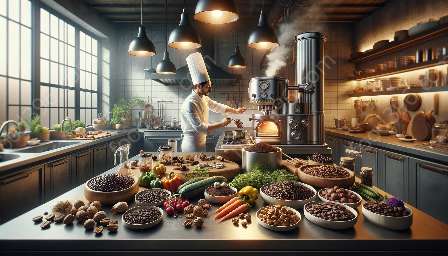Slow roasting is a culinary technique that involves cooking food at low temperatures for an extended period of time. It is a method that enhances the flavors and textures of various dishes, resulting in tender, succulent, and flavorful meals. In this topic cluster, we will explore the art of slow roasting, its compatibility with roasting and other food preparation techniques, as well as provide insights into recipes and tips for achieving the perfect slow-roasted dishes.
Understanding Slow Roasting
Slow roasting involves cooking food, often meats, at temperatures ranging from 200°F to 250°F for an extended period, typically several hours. This low and slow cooking method allows the flavors to develop and intensify, resulting in tender, juicy, and flavorful dishes. The gentle heat also helps break down connective tissues and fat, resulting in melt-in-your-mouth textures.
Compatibility with Roasting
Roasting typically involves cooking food at higher temperatures, often around 350°F to 450°F, for a shorter duration. While slow roasting is a subset of roasting, it differs in terms of temperature and time. Slow roasting allows for a more gradual cooking process, which is ideal for tougher cuts of meats and certain types of vegetables that benefit from longer cooking times.
Benefits of Slow Roasting
The slow roasting technique offers numerous advantages, including:
- Enhanced flavors and aromas: Slow roasting allows the natural flavors to intensify, resulting in rich, complex, and aromatic dishes.
- Tender and succulent textures: The low and slow cooking process yields incredibly tender and juicy meats, making it ideal for cuts that are typically tough.
- Convenience and versatility: Slow roasting is a relatively hands-off method, making it ideal for busy home cooks. It is also versatile and can be used for a wide variety of dishes, from meats to vegetables.
- Caramelization and Maillard reaction: The extended cooking time allows for the development of deep caramelization and the Maillard reaction, resulting in a flavorful and visually appealing exterior on meats and vegetables.
Recipes and Techniques
When it comes to slow roasting, the possibilities are endless. From succulent roasted meats to caramelized vegetables, there are numerous recipes and techniques to explore. Some popular slow-roasted dishes include:
- Slow-roasted pork shoulder with herbs and spices
- Beef brisket slow-roasted to perfection
- Roasted root vegetables with a honey glaze
- Slow-roasted whole chicken with crisp skin
Each of these dishes requires careful attention to temperature, seasoning, and timing to achieve optimal results. By exploring different recipes and techniques, you can discover the nuances of slow roasting and create memorable culinary experiences.
Tips for Perfect Slow Roasting
To achieve the best results when slow roasting, consider the following tips:
- Patience is key: Slow roasting requires patience, as the extended cooking time is essential for developing flavors and textures.
- Season generously: Since the cooking process is prolonged, seasoning the food generously before roasting will ensure that the flavors penetrate deeply.
- Use a roasting rack: Elevating the food on a roasting rack allows for even air circulation and helps prevent the underside from becoming soggy.
- Monitor the internal temperature: Invest in a reliable meat thermometer to ensure that the food reaches the desired level of doneness without overcooking.
- Baste and rotate: Depending on the dish, occasional basting and rotation can help ensure even cooking and beautifully glazed exteriors.
By incorporating these tips into your slow roasting process, you can elevate your dishes and create mouthwatering results.
Conclusion
Slow roasting is a time-honored culinary technique that delivers exceptional flavors and textures. By understanding the art of slow roasting, its compatibility with traditional roasting methods, and exploring recipes and tips, you can embark on a flavorful journey that will delight your senses and elevate your cooking skills.

